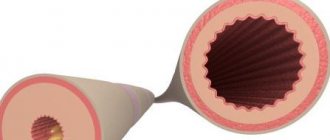Casodex is a drug (tablets) that belongs to the group of antitumor hormonal drugs. The instructions for use highlight the following features of the medicine:
How to dissolve vascular plaques, normalize blood circulation, blood pressure and forget the way to the pharmacy
- Sold only with a doctor's prescription
- During pregnancy: contraindicated
- When breastfeeding: contraindicated
- In childhood: contraindicated
- For liver dysfunction: with caution
- If kidney function is impaired: you can
- In old age: possible
Release form and composition
Casodex is produced in the form of film-coated tablets: biconvex, round, white, with a logo engraved in the form of a rounded arrow on one side, and “50” and “Cdx” (50 mg tablets) or “Casodex 150” on the other. (150 mg tablets), in blisters of 14 pcs., 2 blisters in a cardboard box.
1 tablet contains:
- Active substance: bicalutamide – 50 or 150 mg;
- Auxiliary components (50/150 mg, respectively): lactose monohydrate - 61/183 mg, sodium carboxymethyl starch - 7.5/22.5 mg, povidone - 5/15 mg, magnesium stearate - 1.5/4.5 mg.
Shell composition (50/150 mg, respectively): hypromellose - 2.5/7.5 mg, macrogol 300 - 0.5/1.5 mg, titanium dioxide (E171) - 0.77/2.3 mg.
Pharmacological properties
Pharmacodynamics
Casodex is a racemic mixture characterized by non-steroidal antiandrogenic activity predominantly of the (R)-enantiomer and the absence of any other endocrine activity.
Casodex inhibits the stimulatory effects of androgens by binding to androgen receptors (without activating gene expression). As a result of this process, regression of malignant prostate tumors is achieved.
When discontinuing the drug, clinical antiandrogen withdrawal syndrome may develop in some cases.
In the case of daily use of Casodex at a dose of 150 mg per day with immediate hormonal therapy or adjuvant therapy of locally advanced (T3–T4, any N, M0 or any T, N+, M0) prostate cancer, the likelihood of disease progression and the appearance of bone metastases is significantly reduced.
In the case of locally advanced prostate cancer, in groups of patients who took Casodex at a dose of 150 mg as adjuvant or immediate therapy, compared with standard therapy (radiation therapy, surgical treatment), a trend towards increased life expectancy without symptoms of disease progression was recorded.
In locally advanced prostate cancer, patients receiving Casodex 150 mg as immediate monotherapy or adjuvant treatment in combination with radiation therapy experienced an increase in life expectancy.
In locally advanced non-metastatic prostate cancer, the use of Casodex at a dose of 150 mg compared with surgical castration did not show statistically significant differences in life expectancy and time to progression, with statistically significant benefits in physical condition and sexual function.
Pharmacokinetics
After oral administration, Casodex is absorbed from the gastrointestinal tract quickly and completely. Eating does not affect absorption.
The (R)-enantiomer is excreted from the body much more slowly than the (S)-enantiomer; the half-life of the former is about 7 days.
In the case of daily administration of bicalutamide, due to the long half-life, the content of the (R)-enantiomer in the blood plasma increases approximately 10 times, which makes it possible to use the drug once a day.
In the case of daily administration of bicalutamide at a dose of 150 mg, the equilibrium concentration of the (R)-enantiomer in plasma is approximately 22 μg/ml, and at a dose of 50 mg this figure is approximately 9 μg/ml. At steady state, the active (R)-enantiomer constitutes about 99% of all enantiomers circulating in the blood.
The pharmacokinetics of the (R)-enantiomer is not affected by age, the degree of renal impairment, or the presence of mild to moderate liver dysfunction in the patient. There is information about a slower elimination of the (R)-enantiomer from plasma in patients with severely impaired liver function.
For the racemic mixture, the binding to plasma proteins is 96%, and for the (R)-enantiomer – 99.6%. Actively metabolized in the liver due to oxidation and the formation of conjugates with glucuronic acid. Metabolites are excreted in bile and urine in approximately equal proportions.
The average content of the (R)-enantiomer in the semen of patients receiving Casodex at a dose of 150 mg is about 4.9 μg/ml. In women, low levels of bicalutamide (0.3 mcg/kg) may potentially be detected after sexual intercourse. This amount is below the concentration required to produce changes in fetal development in laboratory animals.
Use of the drug Casodex
Casodex 50 mg. Men, including the elderly: 1 tablet (50 mg) per day. Treatment with Casodex should be started simultaneously with the prescription of an LH-RH analogue or surgical castration. The duration of treatment is determined by the doctor. Casodex 150 mg. Adult men, including the elderly: 1 150 mg tablet orally once daily. Casodex 150 mg should be taken continuously for at least 2 years or until changes in the development of the disease appear. No dose adjustment is required in patients with renal failure and mild liver dysfunction. In order to avoid possible accumulation, Casodex should be prescribed to patients with moderate and severe liver dysfunction with caution.
Instructions for use of Casodex: method and dosage
Casodex is taken orally.
The drug is prescribed to adult men, including elderly patients, 50 mg per day in combination with a gonadotropin-releasing hormone (GnRH) analogue or with surgical castration (treatment should be started simultaneously).
Patients with mild liver dysfunction and renal impairment should not adjust the dose.
In patients with severe and moderate functional liver disorders, the accumulation of Casodex may increase.
Indications for use of the drug Casodex
Indications for Casodex 50 mg . Advanced prostate cancer (late stages); used in combination with an analogue of luteinizing hormone releasing factor (LH-RH) or surgical castration. Indications for Casodex 150 mg . Locally progressive prostate cancer (T3–T4, any N, M0; T1–T2, N+, M0), as a stand-alone drug or as an adjuvant to radical prostatectomy or radiotherapy. Locally progressive, non-metastatic prostate cancer, in cases where surgical castration or other medical intervention is not considered appropriate or possible.
Side effects
During the use of Casodex, disturbances in certain body systems may occur, occurring with varying frequency:
- Very often (≥10%): skin rash, gynecomastia (may persist even after stopping treatment, especially with long-term use of the drug), asthenia, breast tenderness;
- Common (≥1% to <10%): drowsiness, dizziness, depression, anorexia, hot flashes, abdominal pain, itching, constipation, nausea, dyspepsia, weight gain, decreased appetite, dry skin, flatulence, hair regrowth or alopecia, hirsutism, hematuria, decreased libido, erectile dysfunction, edema, chest pain, anemia, jaundice, increased activity of liver transaminases, hepatotoxicity;
- Uncommon (≥ 0.1% to <1%): angioedema, urticaria, hypersensitivity reactions, interstitial pulmonary diseases (fatal cases have been reported);
- Rarely (≥ 0.01% to <0.1%): liver failure (fatal cases have been reported).
Jaundice, cholestasis and increased liver transaminases were rarely assessed as serious. These disorders were transient in nature and decreased or completely disappeared with continued treatment or after discontinuation of Casodex. Very rarely, liver failure developed while taking the drug, but a cause-and-effect relationship has not been reliably established.
Side effects of the drug Casodex
Casodex was well tolerated by most patients, and only in isolated cases did side effects require discontinuation of its use.
Frequency | Organs and organ systems | Side effects |
| Very common (≥10%) | Reproductive system and mammary glands | Breast tenderness 1 Gynecomastia 1 |
| General violations | Feelings of heat1 (hot flashes) | |
| Common (≥1% but ≤10%) | Gastrointestinal disorders | Diarrhea, nausea |
| Disorders of the hepatobiliary system | Increased transaminase activity, jaundice 2 | |
| General violations | Asthenia Itchy skin | |
| Rare (≥0.1% but ≤1%) | The immune system | Hypersensitivity reactions, including angioedema and urticaria |
| Respiratory, thoracic and mediastinal disorders | Interstitial lung diseases | |
| Very rare (≥0.01% but ≤0.1%) | Gastrointestinal disorders | Vomit |
| Skin and subcutaneous tissues | Dry skin | |
| Hepatobiliary system disorders | Liver failure 3 |
1 - The severity of these side effects can be reduced by concomitant castration. 2 - Changes in the liver are most often transient in nature and completely disappear or decrease with continued treatment or after its discontinuation. 3 - Liver failure occurred very rarely, a cause-and-effect relationship has not been established. It is recommended to periodically monitor liver function.
In addition, during clinical studies with the simultaneous use of Casodex and an LH-RH analogue, the following reactions were noted with a frequency of ≥1%, which were regarded as possible side effects: from the cardiovascular system - heart failure; from the gastrointestinal tract - anorexia, dry mouth, dyspepsia, constipation, flatulence; from the central nervous system - dizziness, insomnia, drowsiness, decreased libido; from the respiratory system - shortness of breath; from the genitourinary system - impotence, nocturia; from the blood system - anemia; on the part of the skin and its appendages - alopecia, rash, excessive sweating, hirsutism; from metabolic disorders - diabetes mellitus, hyperglycemia, edema, weight gain, weight loss; general disorders - pain in the abdomen, chest, pelvis, as well as headache, fever. However, a reliable cause-and-effect relationship between these side effects and the therapy has not been established. Some of these effects are general and often occur in elderly patients.
special instructions
In patients with functional liver disorders, it is advisable to periodically evaluate liver function during therapy. In most cases, changes in liver function are observed during the first 6 months of therapy. If severe disorders develop, treatment should be interrupted.
As the disease progresses against the background of an increase in the level of prostate-specific antigen (PSA), discontinuation of therapy may be required.
Caution should be exercised when simultaneous use of Casodex with drugs predominantly metabolized by CYP3A4.
When used simultaneously with coumarin anticoagulants, regular monitoring of prothrombin time is recommended.
Patients with lactose intolerance should note that each 50/150 mg tablet contains 61/183 mg of lactose monohydrate.
During the use of Casodex, dizziness and drowsiness may occur, which is why you need to be careful when driving vehicles or other moving mechanisms.
Drug interactions
When Casodex is used simultaneously with certain medications, undesirable effects may occur:
- Slow calcium channel blockers, cyclosporine: potentiation or development of adverse reactions (dose reduction may be required; careful monitoring of the patient’s clinical condition and the concentration of cyclosporine in the blood plasma is recommended);
- Medicines that inhibit liver microsomal enzymes (for example, ketoconazole, cimetidine): an increase in the concentration of bicalutamide in plasma and, possibly, an increase in the incidence of side effects (caution should be exercised during simultaneous use);
- Indirect coumarin anticoagulants (including warfarin): enhancing their effect (regular monitoring of prothrombin time is recommended).
The simultaneous use of Casodex with terfenadine, cisapride and astemizole is contraindicated.



